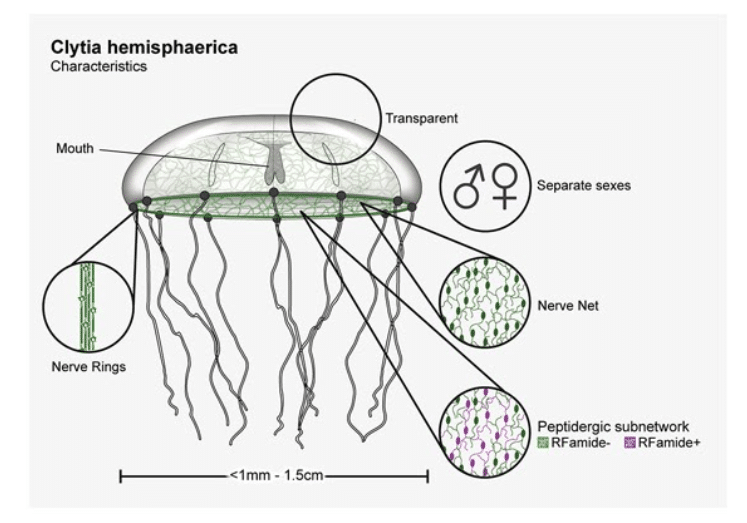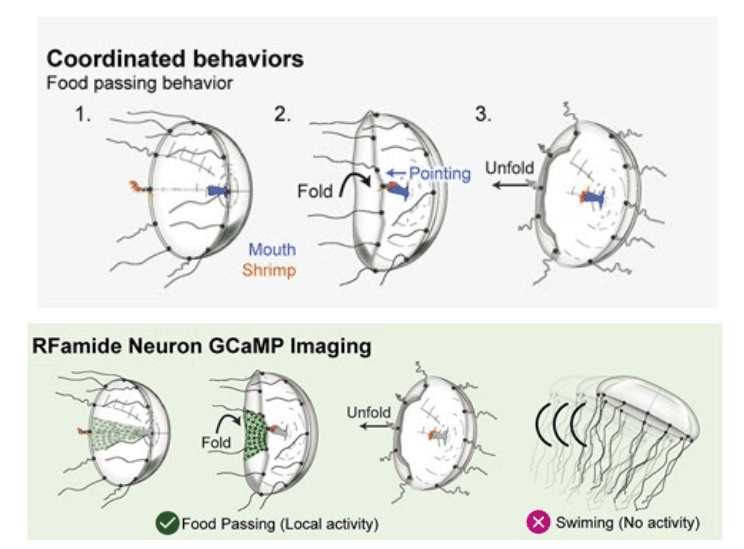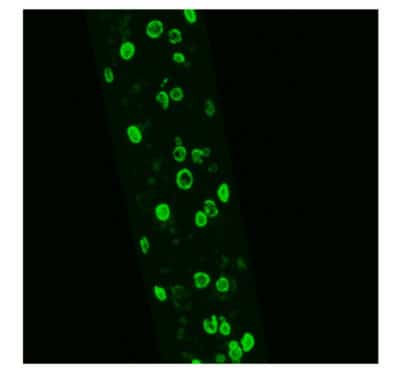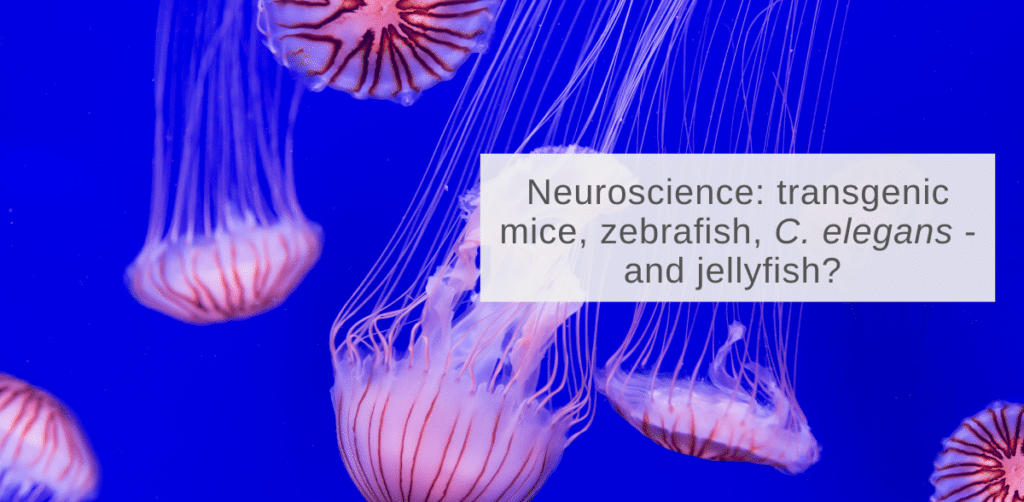Summary: Neuroscience has a long history of working with sea animals as they often have large, easily accessible neurons with more simplistic neural networks than mammals. In a recent publication Weissbourd et al., used genetic manipulation to introduce GCCaMP into jellyfish – creating animals with neurons that glow fluorescent green, and enabling the researchers to observe jellyfish feeding behavior. In this article we discuss Weissbourd’s recent publication as well as GCaMP more broadly, showing how advancing technology has enabled researchers to ask questions that span disciplines and model organism species.

Image 1. Anatomical drawing of the jellyfish used in this study (Weissbourd et al., 2021)
Jellyfish are an intriguing organism for the study of neuroscience because they are transparent and lack a brain – unlike humans, jellyfishes’ behaviours occur through coordinated autonomous body parts. A recent study by Weissbourd et al., created a transgenic line of the jellyfish Clytia hemisphaerica with a GCaMP indicator. This line allowed the researchers to study jellyfishes’ neurons at a systems level (for the first time!) using GCaMP imaging. Specifically, Weissbourd’s team was interested in how jellyfish coordinated their behaviours when eating [Image 2].
What they found was more complex than Weissbourd expected: rather than a system in which any neuron might fire if its neighbor did, there were subgroups of connected neurons that consistently would fire (almost in the shape of a pie slice) [Image 2]. These findings have excited the neuroscience community, with some researchers such as evolutionary developmental biologist Thomas Bosch, saying that this work shows that jellyfish could prove helpful for understanding, “the minimum complexity that a nervous system needs to perform complex behaviors” (McDermott, 2021).
Weissbourd described the benefits of using the jellyfish model, saying that small size and short developmental period makes them an ideal lab animal, while their transparent bodies make them particularly adept for neuroscience research.

Image 2. Drawing of jellyfish feeding behaviors (top). Drawing of transgenic jellyfish depicting the glowing neurons while feeding (bottom) (Weissbourd et al., 2021).
The use of a jellyfish model also enables future comparative studies, as jellyfish are evolutionarily distant from other established model organisms – such as the nematode C. elegans, which is what we at InVivo Biosystems use in studies that require fluorescent tagging. Like jellyfish, C. elegans have a transparent body which makes them an ideal model for fluorescent tagging [Image 3].
Customer Spotlight
One example of work that we’ve done using fluorescent tagging is exploring the temporal overexpression or hypomorphic expression of Lamin proteins (lmn-1) in C. elegans. This customer reached out to us in order to test his hypothesis before moving onto mammalian mouse studies, and we were able to deliver the data he needed to confidently progress to mammalian studies (check out the gorgeous C. elegans photo below) [Image 3].
Our expert team at InVivo Biosystems first created transgenic C. elegans lines that over and under expressed lmn-1 via tagging lmn-1. The team then conducted a phenotypic analysis using a four pronged approach: survival assayed over 25 days, a pharyngeal pumping assay, a movement assay, and nuclear morphology. This analysis revealed that lmn-1 expression did affect worms’ lifespan, and our customer was given the data he needed to pursue move on to using a mammalian system.
This project is exemplary of how researchers can exploit different models and tools to ask the critical questions in the best ways. At InVivo Biosystems we understand that resources are limited (not everyone’s research involves creating new models, as cool as the transgenic jellyfish is!), and so, companies like ours can act as an outsourced researcher, giving you the data you need when your lab doesn’t have the capability to add other models or technologies.
Enhance your research capabilities with our premium transgenic services. With state-of-the-art technology and cutting-edge techniques, we ensure unparalleled accuracy, efficiency, and reliability. Inquire now!

Image 3. Fluorescent Tagging in C. elegans. Intestinal nuclei from late L4 worms in an lmn-1::GFP transgenic strain, expressing our mCherry array markers. (Image courtesy of Dr. André Catic, Baylor College of Medicine).
In addition to fluorescent tagging, we also offer degron tagging and immunotagging services. Learn more about our C. elegans endogenous tagging services here.
References:
Katwala, Amit (2021). A Gene-Tweaked Jellyfish Offers a Glimpse of Other Minds, WIRED https://www.wired.com/story/gene-tweaked-jellyfish-neurology/
McDermott, Amy (2021). Jellyfish species proves its mettle as a neurobiology model organism, PNAS, https://blog.pnas.org/2021/12/jellyfish-species-proves-its-mettle-as-a-neurobiology-model-organism/
Weissbourd et al. (2021). A genetically tractable jellyfish model for systems and evolutionary neuroscience, Cell, 184(24), P5854-5868.E20, https://doi.org/10.1016/j.cell.2021.10.021



